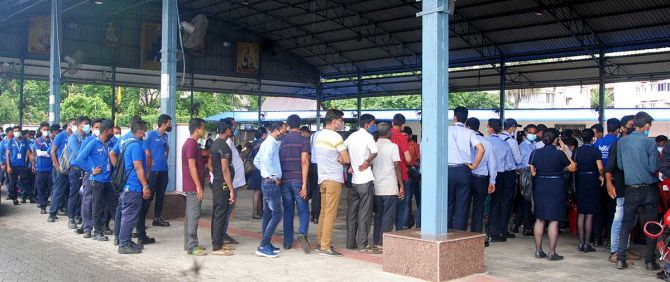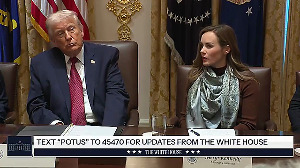Not to say that India couldn't have handled the situation better, but on average, it didn't do anywhere near as badly as the naysayers make it out, argues Rajeev Srinivasan.

If you look beyond the motivated accusations from malign forces, India did about as well or as badly as any other country
There is a loud chorus of voices blaming India for somehow messing up its response to the massive wave of Wuhanvirus (COVID-19) infections that have devastated the country.
Many articles and editorials have come out in both the Indian media and Western media suggesting that the Government of India was negligent, indifferent, or both; in effect that it criminally abdicated its responsibility to the people of India.
It is normal to expect these cavils from political parties and from the mainstream media.
In India the MSM is highly compromised and infiltrated by vested interests, both from local political parties and from foreign powers set on propagating a narrative that leads, inevitably, to regime change, and, preferably, balkanization.
One of these outbursts was an editorial in the Lancet, a British medical journal, that puts the blame squarely on the GoI (with no blame attributed to the state governments, despite the fact that health is a state responsibility).
I used to be impressed by the Lancet as essentially the paper of record in medicine, but a massive screw-up last year in regards to HCQ made me change my mind, and realize that politics takes precedence over science.

I wrote a long essay, Pious Frauds, Pious Frauds? (external link) about how credentialism rather than scientific truth is the hallmark of some of these storied institutions.
The Lancet has been in the middle of several serious frauds, and it is astonishing that they still have a sterling reputation. So I would take their opinions with a large grain of salt, unless supported by impeccable data/evidence, which it is not in this case. Even purportedly neutral scientists and labs labor under agendas.
Here's more on bad faith from the Lancet.
Much the same happened with another cheap, off-patent drug, Ivermectin.
In both these cases, it was not at all convenient for Big Pharma that cheap, generic drugs made mostly in India would eat into their windfall profits.
Let us note that Pfizer made a profit of $15 billion in 2020. Moderna made a profit for the first time in its history in Q1 2021. Also, Gilead Pharma's Remdesivir, that was pushed as some sort of panacea, but in the event it proved mostly useless.
Another case in point is the increasingly vocal allegation that the US government in effect colluded with the Wuhan Institute of Virology to do gain-of-function research in bat coronaviruses, which made them far more potent as well as transmissible to humans.
Anthony Fauci, Peter Daszak, and others look like they concealed conflicts of interest and deliberately propagated the narrative that the Wuhanvirus must have evolved naturally.

Nicholas Wade's seminal essay, republished by the Bulletin of Atomic Scientists, is a scathing indictment of the media and its omerta in burying an important story that somehow didn't fit their narrative: the lab-origin hypothesis, and in particular the conflicts of interests.
See Origin of Covid -- Following the Clues (external link) and a video version at Nicholas Wade: the case for the Covid lab-leak theory (external link)
It looks increasingly likely that the Wuhanvirus was developed in a lab and was either leaked because of poor security in BSL-2 and BSL-3 labs, or, more alarmingly, that it was deliberately released as a bio-weapon. That is significant, for a variety of reasons: of most concern, the possibility of bio-warfare, which would be considered a crime against humanity, considering almost every country has signed treaties against it.
On a more mundane level, it means that the Wuhanvirus outbreaks are in effect, force majeure, by definition things that cannot be defended against or predicted, as they are unpredictable and out of the expected set of possible scenarios.
All of us, individuals and societies alike, make plans based on events with a non-trivial probability. When an extremely improbable event hits -- Nassim Taleb famously called these Black Swan events -- it is beyond the scope of our normal strategic planning.
This goes hand-in-hand with the sensible engineering principle of built-in safety factors.
For instance, an engineer designing anything, a bridge, an aircraft, or a circuit, will assume a certain level of uncertainty, and build in some slack say 30-50% over the designed load. This enables the system to be resilient in the face of a sudden surge or stress on the system.
But there are practical limits to how much safety you can build in, because there is a cost to it.
You can design in 100% or 200% margins of error, or more, but these start to get expensive.
There is a tradeoff: So you take an informed decision about the expected value of the maximum stress. That is what you engineer the system for.
A good example is the Fukushima reactor in Japan. It was (I may be a little bit off on the numbers, but bear with me for the principle) built to withstand an 8.5 earthquake on the Richter scale.
There have been no quakes greater than 8.2 for 500 years, or since accurate records started being maintained. So that seems like a fair tradeoff on cost and risk. In fact, no project manager will approve the budget for reinforcing it to withstand an 8.8 quake.
But what happens if you get hit with a 9.0 earthquake?
The system is overloaded, and all bets are off. There is catastrophic failure.

This is more of less what happened to every health system in the world when the Wuhavirus struck. India is no exception. Neither was the US when it was going through its peak: a year later, there are still hundreds of unclaimed bodies stored in refrigerated trucks; there were mass graves with tens of bodies buried on an island near New York City. Nor was Italy, when people were dying in droves on ventilators. Nor was Osaka, more recently.
There is more: Thailand, Vietnam and several other countries, which had escaped the calamity earlier, are now showing signs of new outbreaks.
The virus continues to ravage the world. So the first point is that it was not humanly possible to fend off the lethal virus, in particular the 617 or Delta variant, which was far more infectious in the second wave: its R0 was greater than 3 or even touching 4 in many places, which implies a combinatorial explosion in terms of infections.
The second point is that India was complacent about how it had escaped catastrophe, and 'boasted' about how it was 'vaccine supplier to the world'.
There is some quote from PM Modi at the World Economic Forum that India had defeated the virus; this is trotted out by all and sundry to show hubris on the part of the Indian government.
This reminds me of the ritual in Silicon Valley companies called the 'massacre of the innocent'.
After every failed project, there is a meeting to apportion blame. Some suitable bystander is anointed as the scapegoat, and the entire thing is blamed on him (it's usually a man).
The actual culprits who messed up are given a pass, and are sometimes promoted.
The point is that if somebody made a reasonable decision, one that was appropriate given the information on hand at the time, cannot be blamed for the circumstances changing later.
Hindsight does not count. Yes, one should anticipate, even war-game, for various scenarios, but you cannot be expected to be omniscient.
By finding a scapegoat (which, historically, comes from a Middle Eastern custom of actually blaming a goat for all the ills that befall the village, and forcing it to wander off into the desert) you allow the real culprits to escape. This is what happens all the time in business, and surely elsewhere too.

Given the circumstances after the first wave subsided around the end of the year, it really did look like the strict lockdown had taken the wind out of the sails of the virus, and India was expecting to produce large volumes of Covishield and Covaxin over the first few months of 2021. So much so that India would give away some doses to small developing countries, and sell a lot more to the Covax alliance that would in turn distribute to the developing world.
Production levels at least for Covishield were seriously affected by a February 2021 (yes, Biden era) ban on exports of critical components under the US Defense Production Act. Belatedly, on June 4th, these restrictions were lifted.
Here's the New Indian Express' coverage:
India was being a good global citizen in providing free vaccine to small countries; the contrast with big developed nations could not be more dramatic -- the latter were ordering 3 or 4 times the total doses they needed.
In addition, the US was hoarding 45 million doses of the AstraZeneca vaccine which isn't approved for use in that country.
Classic dog in the manger syndrome.
There are loud commitments from the G7 to provide a billion doses of vaccine free of cost to poor countries.
This is good, but as Ronald Reagan once said, 'Trust but verify'. I'd like to read the fine print.
Does this mean a billion doses of mRNA vaccines from Pfizer and Moderna?
What about the sovereign guarantees required by Pfizer as well as indemnity against any claims of side-effects?
Who is going to provide that?
To sum it up, I have to fall back upon something from the Christian Bible: "let he who hath not sinned cast the first stone".
Not to say that India couldn't have handled the situation better, but on average, it didn't do anywhere near as badly as the naysayers make it out.
It blundered along, exactly as every other country did.
Feature Presentation: Ashish Narsale/Rediff.com










